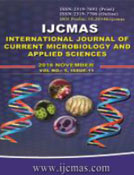


 National Academy of Agricultural Sciences (NAAS)
National Academy of Agricultural Sciences (NAAS)

|
PRINT ISSN : 2319-7692
Online ISSN : 2319-7706 Issues : 12 per year Publisher : Excellent Publishers Email : editorijcmas@gmail.com / submit@ijcmas.com Editor-in-chief: Dr.M.Prakash Index Copernicus ICV 2018: 95.39 NAAS RATING 2020: 5.38 |
Extended spectrum β-lactamase (ESBLs) are enzymes produced by Gram negative bacteria. They are able to hydrolyze extended spectrum cephalosporins, penicillins and monobactams but inactive against cephamycin and imipenem. Various phenotypic methods are used in the routine practice to detect the ESBL production in Gram-negative bacilli. However detection of AmpC β-lactamases is not very common. This study aimed to detect the resistance pattern of cefepime, a fourth generation cephalosporin, among the tested Gram negative isolates collected from Egypt and to compare different phenotypic methods for the detection of ESBL and AmpC production in these isolates. We also studied the induction of cefepime resistance among the tested isolates and tested the stability of this induced resistance. A total of 113 Gram negative clinical isolates were studied. Three dimensional test detected ESBLs in 54 (55.1%) isolates, whereas the double disc synergy test detected ESBLs in 47 (48%) isolates these results were confirmed by the CLSI confirmatory test. The three dimensional test has been found to be better than Double disc synergy test in the detection of ESBLs. Most of the ESBL producing organisms are multi-drug resistant. Cefepime was found to be able to induce resistance towards itself in all the selected isolates, this resistance was found to be stable in the tested isolates. Therefore cefepime should not be used alone for prolonged periods because it induces self-resistance by stimulating bacteria to produce β-lactamases.
 |
 |
 |
 |
 |